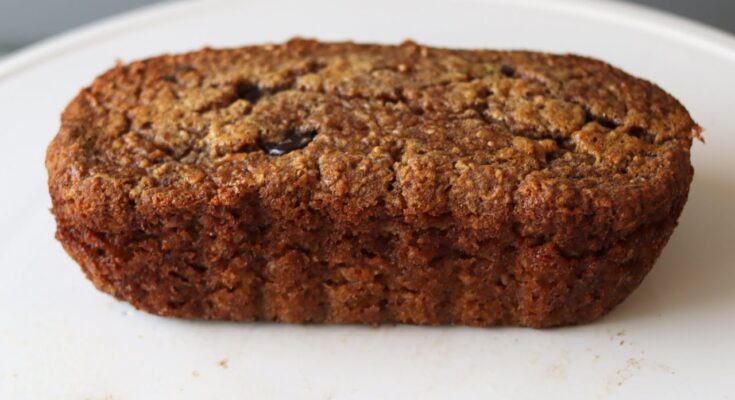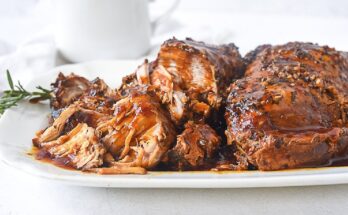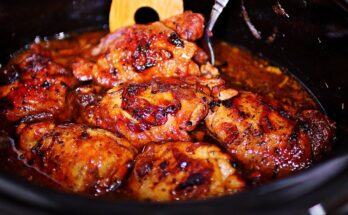Baked Oats Recipe: Baked oats have become one of the most popular breakfast trends in recent years, and for good reason. They’re warm, fluffy, versatile, and taste almost like cake—except they’re made with wholesome ingredients. This recipe guide will walk you through everything you need to know about baked oats, from ingredients and tools to a detailed step-by-step process. Whether you’re looking for a quick healthy breakfast, a nutritious snack, or a guilt-free dessert, baked oats are the perfect choice.
Introduction to Baked Oats
Baked oats are essentially oats that have been blended or mixed with a liquid base (like milk), a binder (such as eggs or banana), and a sweetener, then baked in the oven until fluffy and cake-like. Unlike overnight oats, which are chilled and eaten cold, baked oats are served warm and feel more like a treat than a typical bowl of oatmeal.
One of the reasons baked oats are trending is their versatility. You can make them taste like chocolate cake, banana bread, or even a fruity cobbler depending on the flavors you add. They’re also a great way to satisfy a sweet tooth without reaching for processed desserts.
On top of taste, baked oats are loaded with health benefits. Oats are naturally high in fiber, which helps digestion and keeps you full longer. They’re also a great source of plant-based protein, vitamins, and minerals like magnesium and iron. Depending on the ingredients you use, baked oats can be vegan, gluten-free, or even protein-packed.
So, if you’ve ever wanted a breakfast that feels like dessert but is still good for you, baked oats are your answer.
Ingredients You’ll Need
The beauty of baked oats lies in their simplicity. Most of the ingredients are pantry staples, and you can adjust them to suit your preferences. Let’s break down the basics:
Basic Pantry Staples
- Rolled oats or quick oats – The base of the recipe. Rolled oats give a heartier texture, while blending them makes the oats smoother and more cake-like.
- Milk (dairy or plant-based) – Almond milk, oat milk, or regular milk all work perfectly.
- Egg or flaxseed egg – Acts as a binder. If vegan, flaxseed or chia seed eggs are great alternatives.
- Banana or applesauce – Adds natural sweetness and moisture.
- Baking powder – Helps the oats rise and become fluffy.
- Sweetener of choice – Honey, maple syrup, agave, or even stevia for a low-sugar option.
Optional Flavor Boosters
- Vanilla extract for a dessert-like taste.
- Cinnamon or nutmeg for warmth.
- Cocoa powder for a chocolatey version.
- Fresh or frozen fruits for bursts of flavor.
Substitution Ideas for Dietary Needs
- Gluten-free option: Use certified gluten-free oats.
- Vegan option: Replace the egg with a flaxseed egg and use non-dairy milk.
- Nut-free option: Stick with oat or rice milk and skip nut toppings.
- High-protein option: Add a scoop of protein powder or Greek yogurt to the mix.
The best part is that you don’t need to follow a strict recipe. You can mix and match ingredients depending on what you have at home.
Essential Kitchen Tools for Baking Oats
To make baked oats, you don’t need a fancy setup. A few basic kitchen tools are enough:
- Mixing bowls: For combining wet and dry ingredients.
- Blender (optional): If you want a smooth, cake-like texture, blending the oats with the liquid works wonders.
- Baking dish or ramekins: A small baking dish works for sharing, while ramekins are perfect for single servings.
- Measuring cups and spoons: To get the right proportions.
- Oven: Since baked oats need even heat, an oven is essential.
If you don’t have ramekins, you can use a muffin tin for mini baked oats, which are great for meal prep.
Step-by-Step Guide to Making Baked Oats
Now that you’ve got your ingredients and tools ready, let’s get to the fun part—making baked oats. Follow this step-by-step guide to achieve the perfect, fluffy result every time.
Step 1 – Gather Your Ingredients
Start by measuring out your oats, milk, sweetener, and any add-ins. It helps to have everything on hand before you begin so the process is smooth.
Step 2 – Blend or Mix Your Oats
If you want a cake-like texture, add oats, milk, egg, banana, sweetener, and baking powder to a blender and blend until smooth. For a chunkier, oatmeal-like texture, simply mix everything in a bowl with a spoon.
Step 3 – Prepare the Baking Dish
Lightly grease your ramekin or baking dish with butter, oil, or cooking spray to prevent sticking. This also makes it easier to remove the oats once baked.
Step 4 – Add the Batter and Toppings
Pour the batter into your dish. Add toppings like chocolate chips, berries, or nuts before baking. You can even swirl in peanut butter or Nutella for extra flavor.
Step 5 – Bake to Perfection
Bake in a preheated oven at 350°F (175°C) for 20–25 minutes, or until the top is golden and a toothpick comes out clean. Let it cool slightly before digging in.
The result? A warm, fluffy, cake-like oatmeal that’s both satisfying and healthy.
Creative Flavor Variations
One of the most exciting parts about baked oats is how flexible they are. You can easily switch up the flavors depending on your mood, cravings, or whatever ingredients you have in the kitchen. Think of baked oats as a blank canvas—you can paint it with chocolate, fruits, spices, or even nut butters to create something unique every time. Here are some of the most popular and mouth-watering variations you’ll love trying.
Chocolate Chip Baked Oats
For dessert lovers, chocolate chip baked oats are a dream come true. Simply fold a handful of chocolate chips into your oat batter before baking. The result is a warm, gooey, cake-like dish with melted chocolate pockets inside. You can make it extra indulgent by sprinkling some chocolate chips on top right before baking. Want to keep it healthy? Use dark chocolate chips for an antioxidant boost.
Banana Bread Baked Oats
Banana bread baked oats taste just like the real thing but with far less effort. Mash a ripe banana into your batter, add a pinch of cinnamon, and throw in a handful of walnuts for crunch. This version is naturally sweet, comforting, and perfect for when you have overripe bananas lying around.
Berry Delight Baked Oats
If you prefer something fruity and refreshing, go for berry delight baked oats. Mix fresh or frozen berries (like blueberries, raspberries, or strawberries) into the batter. As the oats bake, the berries burst, releasing sweet, tangy juice that blends beautifully with the fluffy oats. A sprinkle of powdered sugar or a drizzle of honey on top takes it to another level.
Protein-Packed Baked Oats
For those who want a filling post-workout meal, protein-packed baked oats are the way to go. Add a scoop of vanilla or chocolate protein powder to the batter. You can also mix in Greek yogurt for extra creaminess and protein. Pair this version with nut butter swirls or chopped nuts for a satisfying, energy-boosting breakfast.
The key takeaway? You’ll never get bored with baked oats. From chocolate lovers to fruit fans, there’s a version for everyone.
Tips for Perfect Baked Oats
Even though baked oats are simple, a few tricks can help you achieve that perfect fluffy, moist texture every single time. Think of these tips as your cheat sheet for mastering the art of baked oats.
Avoiding Dryness
The most common issue with baked oats is dryness. To prevent this, make sure you use enough liquid in the batter. A good rule of thumb is a 1:1 ratio of oats to milk, plus extra moisture from bananas or applesauce. Also, don’t overbake—remove the oats from the oven as soon as the top sets and a toothpick comes out clean.
Getting a Fluffy Texture
If you want your baked oats to resemble cake rather than oatmeal, blending is the secret. When you blend oats with the wet ingredients, the mixture turns into a smooth batter that rises beautifully in the oven. Baking powder also plays an important role in fluffiness, so don’t skip it.
Adjusting Sweetness Naturally
Instead of relying on refined sugar, use natural sweeteners like honey, maple syrup, or mashed banana. Not only do they keep your oats healthy, but they also add extra depth of flavor. If you’re aiming for low-sugar baked oats, try adding cinnamon or vanilla extract—they give the illusion of sweetness without the calories.
Bonus Tip: Play with Layers
For a fun twist, layer your batter with fillings. Pour half of the mixture into your dish, add a spoonful of Nutella, peanut butter, or jam in the middle, then cover with the rest of the batter. Once baked, you’ll have a delicious surprise filling inside.
With these tips, your baked oats will turn out soft, flavorful, and Instagram-worthy every time.
Storage and Reheating Tips
One of the best things about baked oats is how well they store. Whether you’re making a single portion or a batch for the week, baked oats can be enjoyed fresh out of the oven or reheated later. Here’s how to keep them at their best:
How to Store Leftovers
Allow the baked oats to cool completely before storing. If you leave them warm, condensation can make them soggy. Transfer leftovers into an airtight container and refrigerate. They’ll stay fresh for up to 4 days in the fridge.
Best Ways to Reheat
When you’re ready to eat, you can reheat baked oats in the microwave for 30–60 seconds, depending on portion size. If you prefer a crispy top, pop them back in the oven at 350°F for about 10 minutes. Adding a splash of milk before reheating helps restore moisture.
Freezing Baked Oats
Yes, you can freeze baked oats! Wrap individual portions tightly in plastic wrap or place them in freezer-safe containers. They’ll last for up to 2 months. When you’re ready to enjoy, thaw overnight in the fridge and reheat in the microwave or oven.
Batch-prepping baked oats this way is perfect for busy mornings. You’ll have a healthy, homemade breakfast ready in minutes.
Nutritional Benefits of Baked Oats
Baked oats are more than just tasty—they’re packed with nutrients that support a healthy lifestyle. Here’s a closer look at why they make such a smart choice for breakfast or snacks.
High Fiber Content
Oats are rich in dietary fiber, particularly beta-glucan, which helps regulate blood sugar levels, lowers cholesterol, and promotes gut health. Eating fiber-rich meals like baked oats keeps you full for longer, reducing the urge to snack on unhealthy foods.
Protein Boost
While oats themselves contain some protein, adding eggs, milk, or protein powder boosts the protein content significantly. This makes baked oats an excellent option for muscle recovery after workouts or for those trying to maintain a high-protein diet.
Low Sugar Options
Unlike sugary cereals or pastries, baked oats can be made with natural sweeteners and minimal added sugar. You’re in control of how sweet you want them. Using fruits like bananas, apples, or berries naturally sweetens the oats while adding vitamins and antioxidants.
Nutrient-Rich Add-Ins
You can make your baked oats even more nutritious by adding extras like chia seeds (omega-3 fatty acids), nuts (healthy fats), or spinach (iron and vitamins). This flexibility ensures you get a balanced meal every time.
In short, baked oats check all the boxes: filling, nutrient-dense, and versatile enough to support a healthy diet.
Serving Ideas for Baked Oats
Baked oats are one of those versatile dishes you can enjoy in different ways depending on the occasion. Whether you want a cozy breakfast, a quick snack, or a dessert-inspired treat, baked oats can fit the bill. Let’s explore some delicious serving ideas to elevate your baked oats experience.
As a Wholesome Breakfast
The most common way to enjoy baked oats is as a breakfast dish. Fresh out of the oven, they’re warm, fluffy, and comforting—perfect for starting your day on the right note. Pair them with a cup of coffee or tea, and you’ve got yourself a filling, energizing meal. To make breakfast even more satisfying, top your baked oats with Greek yogurt, fresh fruits, or a drizzle of nut butter.
As a Healthy Snack
Baked oats aren’t just for mornings—they also work great as an afternoon pick-me-up. You can bake them in muffin tins for individual portions, making them easy to pack and take on the go. Instead of reaching for a processed snack bar, grab a baked oats muffin that’s loaded with fiber and protein. They’re portable, mess-free, and will keep your energy steady throughout the day.
As a Dessert Twist
Here’s where baked oats really shine—they can double as dessert. Imagine serving warm chocolate baked oats with a scoop of vanilla ice cream on top, or berry baked oats drizzled with honey and whipped cream. It’s a healthier alternative to traditional cakes or pies, yet still feels indulgent. For dinner parties, baked oats served in small ramekins can make an impressive yet simple dessert option.
The takeaway? Baked oats aren’t limited to one category of food—they’re versatile enough to play multiple roles throughout your day.
Common Mistakes to Avoid
Even though baked oats are beginner-friendly, a few common mistakes can affect the final result. Avoid these pitfalls to ensure your oats come out perfect every time.
Overbaking the Oats
The most frequent mistake is leaving baked oats in the oven too long. Overbaking leads to a dry, rubbery texture. The key is to check them at the 20-minute mark. If a toothpick comes out clean or with a few moist crumbs, they’re ready. Remember, they continue to cook slightly as they cool.
Using the Wrong Type of Oats
Instant oats often become mushy, while steel-cut oats don’t soften enough in the baking time. The best option is rolled oats or quick oats. They strike the perfect balance between soft and chewy.
Skipping Blending (When Needed)
If you’re aiming for a cake-like version, blending the batter is essential. Without blending, the oats will stay chunky, creating more of a baked porridge texture. Neither is wrong, but you should decide what texture you want before skipping this step.
Forgetting Baking Powder
Baking powder is what makes baked oats rise and turn fluffy. Without it, your dish may end up dense and heavy. Always double-check that you’ve added it to the mix.
By avoiding these mistakes, you’ll save yourself from disappointing results and ensure every batch is a winner.
Baked Oats vs. Overnight Oats
Oats are a breakfast superstar, but baked oats and overnight oats couldn’t be more different. Let’s break down how these two methods compare so you know when to choose one over the other.
Texture and Temperature
- Baked Oats: Warm, fluffy, and cake-like. Perfect for colder mornings or when you want a hearty meal.
- Overnight Oats: Creamy, cold, and pudding-like. Ideal for hot summer days or when you need a no-cook option.
Prep and Convenience
- Baked Oats: Requires oven time but can be batch-prepped for the week. Best when you have 20–25 minutes to spare.
- Overnight Oats: Requires no cooking, just soaking oats overnight. Ready-to-go breakfast for busy mornings.
Flavor Possibilities
Both are versatile, but baked oats often feel more indulgent, like dessert for breakfast. Overnight oats, on the other hand, lean more toward fresh and fruity flavors.
So, which is better? The answer depends on your mood. If you crave warmth and comfort, baked oats are the way to go. If you want quick convenience, overnight oats are unbeatable.
Gluten-Free and Vegan Options
Baked oats are naturally adaptable, which makes them perfect for people with dietary restrictions. Whether you’re gluten-free, vegan, or both, there’s a way to enjoy them without sacrificing taste or texture.
Gluten-Free Baked Oats
Oats themselves don’t contain gluten, but cross-contamination during processing is common. To stay safe, always choose certified gluten-free oats. Pair them with gluten-free baking powder, and you’re good to go.
Vegan Baked Oats
Going egg-free and dairy-free is easy with baked oats. Replace eggs with flaxseed eggs (1 tablespoon ground flax + 3 tablespoons water) or chia seed eggs. Use almond milk, oat milk, or soy milk instead of dairy. The result? Still fluffy and delicious.
Ensuring Rich Texture Without Animal Products
The trick to keeping vegan baked oats moist is adding ingredients like mashed banana, applesauce, or nut butters. They add both binding power and richness. Coconut oil or vegan butter can also enhance the texture.
With these swaps, anyone can enjoy a slice of baked oat goodness.
FAQs about Baked Oats Recipe
Q1: Can I make baked oats without eggs?
Yes! Replace eggs with flaxseed or chia seed eggs for a vegan-friendly option. They provide the same binding effect while keeping the dish fluffy.
Q2: How long do baked oats last in the fridge?
Stored in an airtight container, baked oats will stay fresh for up to 4 days in the refrigerator.
Q3: Do baked oats taste like cake?
If blended and baked with baking powder, yes—baked oats can taste surprisingly similar to cake. Otherwise, they have a softer, oatmeal-like texture.
Q4: Can I prepare baked oats ahead of time?
Absolutely. You can mix the batter and refrigerate it overnight, then bake it the next morning. Or bake a batch, store it, and reheat portions as needed.
Q5: What’s the best milk for baked oats?
Any milk works—dairy, almond, oat, soy, or coconut. Each type gives a slightly different flavor and creaminess.
Conclusion
Baked oats are more than just a breakfast trend—they’re a wholesome, versatile dish that fits into any lifestyle. With endless flavor combinations, simple ingredients, and plenty of health benefits, they make a fantastic option for breakfast, snacks, or even dessert. The best part? You can customize them to match your dietary needs, whether vegan, gluten-free, or high-protein.
So, the next time you crave something sweet yet nourishing, whip up a batch of baked oats. Experiment with flavors, try different toppings, and make it your own. After all, healthy food should never be boring.



